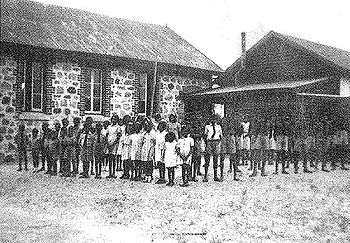- Marribank
-
Marribank, also known as Carrolup, was the site of one of two large camps for Indigenous Australians established by the office of the Protector of Aborigines of the Western Australian State Government.
It was established not far from the Western Australian town of Katanning, after complaints by white farmers and settlers about the Aboriginal fringe dwellers living north of the town, who were attending school to the south. Together with settlements at Moore River, Roelands and Gnowangerup, at one stage it formed part of a number of institutions that housed most of the Noongar people of the South West of Western Australia. The "Aboriginal Act" of 1909 denied the rights of parents and made all part-Aboriginal children wards of the state. Aboriginal children were taken from their parents, especially if they had a European or part-European ancestry, in order to break the possibility of being socialised within traditional Aboriginal language and culture, as a part of a government policy which has become known as the Stolen Generations. It was hoped by the Protector of Aborigines that boys would be trained as agricultural labourers, and girls would obtain work as domestic servants. Children living at Carrolup of marriageable age had to obtain official government permission to marry. As the official policy was acknowledged as "smoothing the pillow of a dying race", the "breeding out" of Aboriginal racial characteristics was encouraged. The officials took little or no action in cases of sexual abuse of girls by those officially in charge of them.
In the 1950s, Marribank was the site of an Aboriginal Noongar Art movement amongst the children resident there, famous for its portrayals of local Western Australian scenes at sunset. An exhibition of Carrolup artists was organised in Perth, in a number of Australian towns and cities and in London. A number of prominent Western Australian Aboriginal Artists started their work at Marribank.
Today, Marribank houses a small museum and is administered under Aboriginal control.
Categories:- History of Indigenous Australians
- History of Western Australia
- Stolen Generations institutions
Wikimedia Foundation. 2010.

